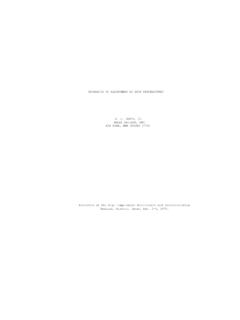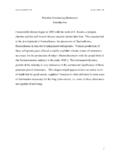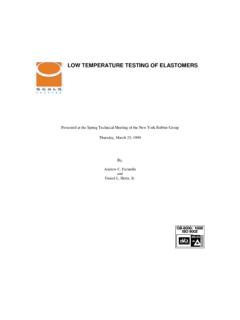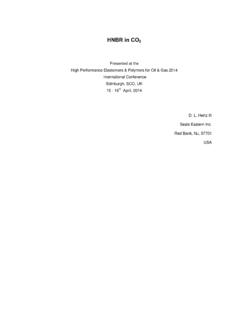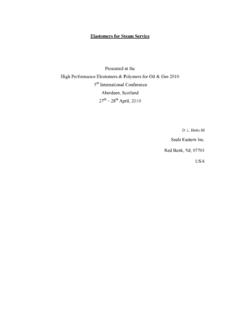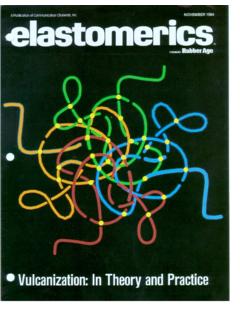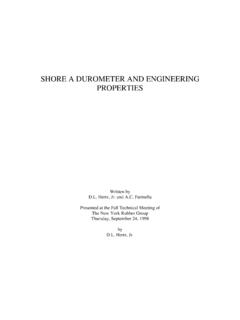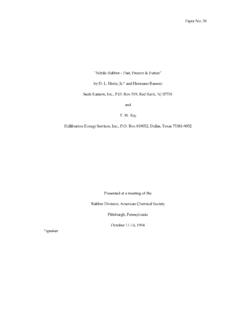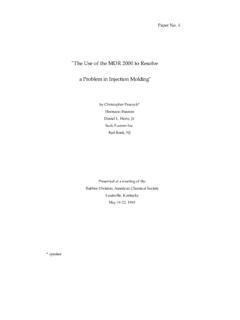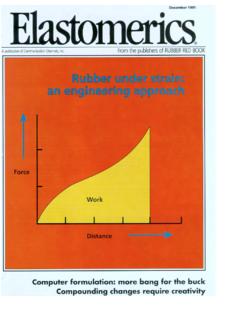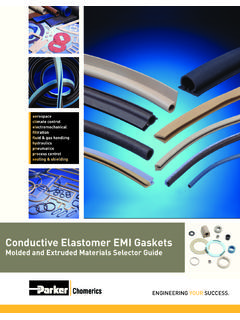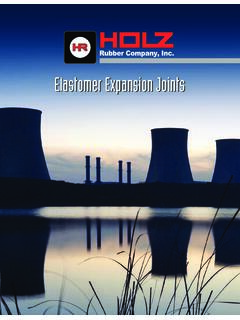Transcription of SOUR HYDROCARBONS - THE ELASTOMER CHALLENGE'
1 Contribution No. 34 SOUR HYDROCARBONS - THE ELASTOMER CHALLENGE' Hertz, Jr. Seals Eastern Inc. Red Bank, 07701 Presented at a meeting of the Rubber Division, American Chemical Society Las Vegas, Nevada, May 20-23, 1980 INTRODUCTIONH ydrofluorocarbon elastomers , ASTM designation D1418-FKM, areproduced domestically by Dupont and 3M Company under the trade names ofViton and Fluorel. FKM elastomers have been extensively studied, and amplepublished information is available both from suppliers and from journalssuch as Rubber Chemistry and Technology(RC&T). This paper deals primarilywith interactions resulting from increasing weight-per cent of fluorine andincreasing molecular weight of FKM elastomers in the "sour" hydrocarbonenvironment, not previously reported.
2 With a few exceptions, most of thedata utilized are available from RC&T and the Rubber Division's book"Science and Technology of Rubber."EXPERIMENTALE arly work on FKM formulations had indicated high molecular weight polymers(FKM1C) had superior mechanical properties in gas-liquid refrigerationapplications. Initial testing in the sour crude environment confirmed thisobservation. We believed increasing weight-per cent fluorine elastomers would showfurther improvements, a fallacious cleavage was presumed and subsequently proven as anotherincorrect assumption1. This led to a more rigorous evaluation of molecularweight relationships and physical modulus characteristics, key properties ofthe original FKM seal compounds.
3 DISCUSSION AND RESULTSE lastomers-The PanoramaMechanical "The strength and extensibility of an elastomerdepend on its overall viscoelastic properties." This is part of Smith'sintroductory statement in his paper, "Strength of elastomers -A Perspective."2 Table I from this work neatly defines the ELASTOMER we are studying. Strengthand toughness are desired physical characteristics, one created by molecularmobility and the other by molecular immobility, a two phase condition, notavailable in hydrofluorocarbon (FKM) elastomers . FKM elastomers are categorizedaccording to Smith as: filled, single-phase, non-crystalline state and 13is an idealized plot of shearmodulus versus temperature.
4 This curve represents all single phase,non-crystalline, filled or unfilled, crosslinked elastomers . The highestshear value represents the fracture energy of a typical crystalline 1000 fold decrease in shear modulus with increasing temperature is atypical characteristic of this category of elastomers . Logically, increasingmolecular weight increases the melt temperature,and crosslinking extends therubbery 2, modulus (Young's modulus E) vs. temperature is a plot of realworld FKM1 data4representing the circled area in Figure 1. Shear modulus is 1/3to 1/4 Young's modulus (dependent on filler loading).
5 This transition zone shouldbe avoided in dynamic dramatic degree of change in shear modulus versus temperaturepoints out the viscoelastic nature of elastomers . A more comprehensivebackground is furnished by reviewing the failure envelope concept: Failure envelope ,6, in some landmark work, developed hisconcept of ultimate properties, a major contribution. Earlier, William's, Landel,and Ferry, with their WLF equation, pointed out that allpolymers, regardless oftheir chemical structure, will exhibit similar viscoelastic behavior at equaltemperature intervals (T-Tg) above their respective glass-transition has added to this concept by showing that the ultimate tensile properties ofa non-reinforced, amorphous, crosslinked ELASTOMER can be characterized by afailure envelope which is independent of time (strain rate)
6 And 3 from Reference 5 schematically illustrates the general effect ofstrain rate and temperature on the tensile, stress-strain properties of amorphouselastomers. The lines originating from 0 represent stress-strain curves determinedat various strain rates and temperatures. The envelope ABC connects the rupturepoints. The rupture point moves counter clockwise around the "failure envelope" aseither the strain rate is increased or the test temperature is represents classical stress-strain behavior. DE and DF representstress-relaxation and creep terminating in an equilibrium state.
7 The dotted linesfrom G represent stress relaxation and creep terminating in a potential stress-strain curves represent the nonlinear viscoelastic response ofan amorphous ELASTOMER to an imposed strain, increasing directly proportionally more recent work, Landel7shows an interesting series of FKMelastomer stress-strain curves (Figure 4) plotted logarithmically. The curves,progressively displaced upward as the temperature is decreased,3 are terminated at a point representing rupture. The family of curvesrepresents a decreasing temperature run at one strain rate with thetemperature normalized to Kelvin.
8 By plotting an envelope around the rupturepoints, the curve in (Figure 3) is now 's next approach was to run a non-reinforced FKM2elastomer and plot the log of stress and strain atbreak, as shown in (Figure 5)(as opposed to the previous (Figure 4), which was plotted as the log of stressversus strain). The data points reflect 10 strain rates (from to 20 inches perminute) for each of the nine temperatures noted. Again, the familiar paraboliccurve is apparent. The data scatter in the low temperature area is understandablein light of the Tg curve (Figure 1) and the Meyer-Ferri curve (Figure 10).
9 Bothfigures indicate that the rubbery characteristic is becoming "blurred" in thistemperature range because microcrystallinity is I points out the contribution of fillers to thesource of strength of elastomers . At elevated temperatures, the contributionbecomes greatly minimized8as evidenced by Figures 69and 710. The data, developedby Greensmith, Mullins, and Thomas11and plotted by Gent, represents criticalfracture energy Gc, or critical strain energy release. The validity of a hightemperature design model based on stress-strain properties for an unfilled,single-phase, non-crystallizable ELASTOMER is more apparent after reviewing thesefigures.
10 There is an obvious contribution by specific fillers at highertemperatures, but it is the contribution toward higher shear modulus rather thantrue stress at Crosslink crosslink density affects physical properties in thegeneralized manner described by Figure 812. Dependence of true stress at break for an FKM1C(highest molecular weight) ELASTOMER with varying diamine curative levels is illustrated byFigure 913. The diamines are not as efficient as the newer bisphenols. The physicalcontribution of chain entanglements is very apparent. The peak stress at break values areformulations that would be considered "undercured" by conventional compounding data14and other references15,16give ample technical details of crosslinkingchemistry.
